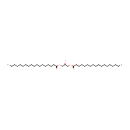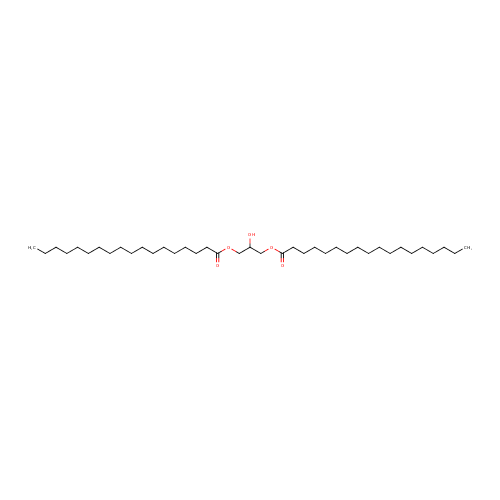|
Record Information |
|---|
| Version |
1.0 |
|---|
| Update Date |
1/22/2018 11:54:54 AM |
|---|
|
Metabolite ID | PAMDB003691 |
|---|
|
Identification |
|---|
| Name: |
DG(18:0/18:0/0:0) |
|---|
| Description: | DG(18:0/18:0/0:0) belongs to the family of Diacylglycerols. These are glycerolipids lipids containing a common glycerol backbone to which at least one fatty acyl group is esterified. DG(18:0/18:0/0:0) is also a substrate of diacylglycerol kinase. It is involved in the phospholipid metabolic pathway. |
|---|
|
Structure |
|
|---|
| Synonyms: | - 1,2-dioctadecanoyl-rac-glycerol
- 1,2-distearoyl-rac-glycerol
- DAG(18:0/18:0)
- DAG(36:0)
- DG(18:0/18:0)
- DG(36:0)
- Diacylglycerol
- Diacylglycerol(18:0/18:0)
- Diacylglycerol(36:0)
- Diglyceride
|
|---|
|
Chemical Formula: |
C39H76O5 |
|---|
| Average Molecular Weight: |
625.0177 |
|---|
| Monoisotopic Molecular
Weight: |
624.569275542 |
|---|
| InChI Key: |
IZHVBANLECCAGF-UHFFFAOYSA-N |
|---|
| InChI: | InChI=1S/C39H76O5/c1-3-5-7-9-11-13-15-17-19-21-23-25-27-29-31-33-38(41)43-35-37(40)36-44-39(42)34-32-30-28-26-24-22-20-18-16-14-12-10-8-6-4-2/h37,40H,3-36H2,1-2H3 |
|---|
| CAS
number: |
Not Available |
|---|
| IUPAC Name: | 2-hydroxy-3-(octadecanoyloxy)propyl octadecanoate |
|---|
|
Traditional IUPAC Name: |
2-hydroxy-3-(octadecanoyloxy)propyl octadecanoate |
|---|
| SMILES: | CCCCCCCCCCCCCCCCCC(=O)OCC(O)COC(=O)CCCCCCCCCCCCCCCCC |
|---|
|
Chemical Taxonomy |
|---|
|
Taxonomy Description | This compound belongs to the class of organic compounds known as 1,3-diacylglycerols. These are diacylglycerols containing a glycerol acylated at positions 1 and 3. |
|---|
|
Kingdom |
Organic compounds |
|---|
| Super Class | Lipids and lipid-like molecules |
|---|
|
Class |
Glycerolipids |
|---|
| Sub Class | Diradylglycerols |
|---|
|
Direct Parent |
1,3-diacylglycerols |
|---|
| Alternative Parents |
|
|---|
| Substituents |
- 1,3-acyl-sn-glycerol
- 1-alkyl,3-acylglycerol
- Fatty acid ester
- Fatty acyl
- Dicarboxylic acid or derivatives
- Secondary alcohol
- Carboxylic acid ester
- Carboxylic acid derivative
- Hydrocarbon derivative
- Organooxygen compound
- Carbonyl group
- Alcohol
- Aliphatic acyclic compound
|
|---|
| Molecular Framework |
Aliphatic acyclic compounds |
|---|
| External Descriptors |
Not Available |
|---|
|
Physical Properties |
|---|
| State: |
Not Available |
|---|
| Charge: | 0 |
|---|
|
Melting point: |
Not Available |
|---|
| Experimental Properties: |
|
|---|
| Predicted Properties |
|
|---|
|
Biological Properties |
|---|
| Cellular Locations: |
Membrane |
|---|
| Reactions: | |
|---|
|
Pathways: |
Not Available |
|---|
|
Spectra |
|---|
| Spectra: |
|
|---|
|
References |
|---|
| References: |
- Yannai, Shmuel. (2004) Dictionary of food compounds with CD-ROM: Additives, flavors, and ingredients. Boca Raton: Chapman & Hall/CRC.
- Yurtsever D. (2007). Fatty acid methyl ester profiling of Enterococcus and Esherichia coli for microbial source tracking. M.sc. Thesis. Villanova University: U.S.A
|
|---|
| Synthesis Reference: |
Not Available |
|---|
| Material Safety Data Sheet (MSDS) |
Not Available |
|---|
|
Links |
|---|
| External Links: |
| Resource | Link |
|---|
| CHEBI ID | Not Available | | HMDB ID | HMDB07158 | | Pubchem Compound ID | 101269 | | Kegg ID | Not Available | | ChemSpider ID | 91503 | | Wikipedia ID | Not Available | | BioCyc ID | Not Available |
|
|---|


